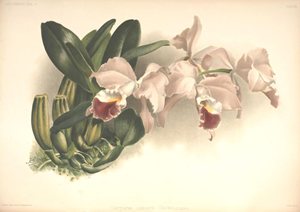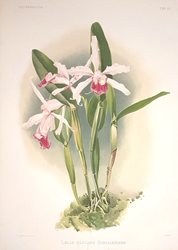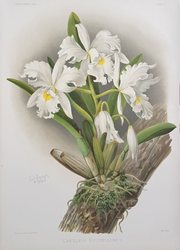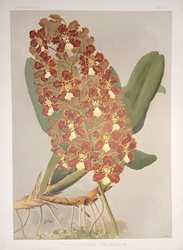
Hanover-born nurseryman of Hertfordshire, Henry Frederick Conrad Sander (1847-1920) said,
"It is vain to tell us that Orchids will ever cease to be appreciated. Their variety, sweetness and grace, their endurance, their exquisite colours, and finely undulated forms are so enchanting and valuable. No other flowers possess so many and such varied charms…"
Baptized Heinrich Friedrich Conrad, Frederick anglicized his name when he emigrated to London in 1865 and began work at the large nursery of James Carter & Co. in Forest Hill. Sander formed a bond with Czech gardener, traveller, and major plant collector Benedikt Roezl (1823-1885) who was more than 20 years his senior. Roezl was considered the world’s greatest collector of orchids at that time, and he was dissatisfied with the limited financial success from sale of the orchids he provided for the Carter nursery.
A growing passion for orchids
After marrying the daughter of a wealthy printer in 1870, Frederick Sander resigned his position at Carter & Co. and set up his own business selling plant seeds, in St Albans, north of London. The enormous quantity of orchids and other tropical plants Roetzl sent, filled a very large warehouse near Sander’s seed shop. Sander had built his first greenhouse for tropical plants by 1873, but he was smitten with the beauty of orchids. In 1881 he acquired land in St Albans and built a nursery and home on 4 acres (1.6 hectares) known as ‘The Camp’ (being the site of an early Roman encampment). He soon employed his own orchid collectors to search the world for more specimens. At one stage Sander employed 23 collectors.
In his nursery he harvested seed and evaluated new orchid hybrids. His nursery, Sander’s of St Alban’s, extended to 60 greenhouses, with tropical orchids thriving despite the English climate. In the 1880s and 1890s Sander’s nursery handled around 2 million plants and became the largest source of orchid culture in Europe. He opened a nursery in the United States, at Summit, New Jersey and one of his botanist collectors, Forsterman, managed this branch, but the logistics of distance proved to be unmanageable, and the nursery was sold in 1896. To cater for the ever-increasing European demand for orchids, in 1894 at St André in Bruges, in north-west Belgium, Sander established an even larger nursery that expanded to 250 glass-houses – 50 of which contained orchid plants, and the remainder contained Kentia palms from seed from Lord Howe Island, and other palms, bay trees, begonias, azaleas, camellias and dracaenas.



Orchids, beautifully recorded
In 1885, when collection of specimens by orchid fanciers throughout the world seemed to threaten the extinction of many rare orchids – a situation to which Sander had no doubt contributed - he decided to record all the orchid classes while they were still available. Reichenbachia. Orchids illustrated and described by F. Sander, with the assistance of scientific authority, was published between 1888 and 1894. Reichenbachia is one of the finest-illustrated botanical works ever published. Sander employed talented botanical artists and wrote in the Introduction to Reichenbachia Orchids "… we shall leave much to our artists, - a few strokes of the pencil and brush will often say more than a page with the pen." Sander’s aim was "to illustrate all classes of the Orchid family” and “to represent truthfully the natural aspect of the plants” – life-size where possible. While a few lithographs were from paintings by A.H. Loch, J.L. Macfarlane, J.H. Walton, Charles Storer, and Georg Hansen, most of the orchid lithographs were from paintings by Henry George Moon (1857-1905).
192 lithographs were printed in colour from exquisitely natural-looking watercolours. Each lithographic plate was signed by the artist to show his approval, and Sander closely monitored all work. Joseph Mansell drew and lithographed 122 plates. Gustav Leutsch drew and lithographed 67, and J.L. Macfarlane painted and lithographed the remaining 3. The lithographs are 54.5 x 42 cm (21.5 x 16 inches). Each orchid was described in English, French and German by Heinrich Gustav Reichenbach (1823-1889), who devoted his life to the study of orchids, and is honoured in the title of the work.
Having studied orchids with his father from the age of 18, Heinrich Gustav Reichenbach gained his Doctorate in Botany in 1852, for his study of pollen in orchids. At the age of 27 he contributed his drawings to his father, Heinrich Gottlieb Ludwig Reichenbach's work on European orchids. In 1863 Dr. Reichenbach was Professor of Botany at Hamburg University and Director of Hamburg Botanic Gardens. After the death in 1865 of the ‘father of orchidology’, his friend John Lindley, H.G. Reichenbach became the world’s leading authority on orchids.
Henry Moon, principal artist for Reichenbachia Orchids
After leaving school Henry Moon attended Birkbeck, now part of London University. He also studied art at Saint Martin’s in London. After his father died in 1866, Moon worked as a clerk in a law firm, but by 1880 he had found work of a more artistic nature. He illustrated a number of botanical works for gardener-journalist William Robinson – including the popular journal simply called The Garden. In 1884 Henry Moon visited Sander’s St Alban nursery to make drawings for Robinson’s The English Flower Garden. Appreciating the unconventional natural representation Moon achieved with his botanical illustrations, in 1885 Sander commissioned him to do watercolours for his orchid publication. The quality of Henry Moon’s orchid paintings established his reputation as a fine botanical artist.
Years after he died, prominent English artist, Reginald Edward Arnold commented,
"H. G. Moon was very close to nature, and primarily, for this reason he stands out as, perhaps, the greatest of all British flower painters,... His plants live, there is an atmosphere of reality about them, and instantly (when viewing one of his pictures) is the plant's natural surroundings, its natural environment, cast vividly upon one's mind."
Reichenbachia Orchids are spectacular lithographs that are rarely found in good condition so choose while original lithographs are available at Antique Prints - Orchids.